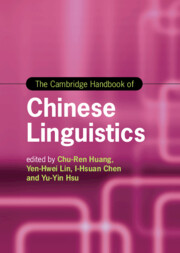Book contents
- The Cambridge Handbook of Chinese Linguistics
- Cambridge Handbooks In Language and Linguistics
- The Cambridge Handbook of Chinese Linguistics
- Copyright page
- Contents
- Figures
- Tables
- Contributors
- Acknowledgments
- Part One Writing System/Neuro-cognitive Processing of Chinese
- Part Two Morpho-lexical Issues in Chinese
- Part Three Phonetic-phonological Issues in Chinese
- Part Four Syntax-semantics, Pragmatics, and Discourse Issues
- 19 SVO as the Canonical Word Order in Modern Chinese
- 20 SOV as the Canonical Word Order in Modern Chinese
- 21 Semantic and Pragmatic Conditions on Word Order Variation in Chinese
- 22 The Case for Case in Chinese
- 23 The Case without Case in Chinese
- 24 The Syntax of Classifiers in Mandarin Chinese
- 25 The Chinese Classifier System as a Lexical-semantic System
- 26 Syntax of Sentence-final Particles in Chinese
- 27 Sentence-final Particles
- 28 Topicalization Defined by Syntax
- 29 An Interactive Perspective on Topic Constructions in Mandarin
- 30 Grammatical Acceptability in Mandarin Chinese
- Index
- References
29 - An Interactive Perspective on Topic Constructions in Mandarin
Some New Findings Based on Natural Conversation
from Part Four - Syntax-semantics, Pragmatics, and Discourse Issues
Published online by Cambridge University Press: 04 August 2022
- The Cambridge Handbook of Chinese Linguistics
- Cambridge Handbooks In Language and Linguistics
- The Cambridge Handbook of Chinese Linguistics
- Copyright page
- Contents
- Figures
- Tables
- Contributors
- Acknowledgments
- Part One Writing System/Neuro-cognitive Processing of Chinese
- Part Two Morpho-lexical Issues in Chinese
- Part Three Phonetic-phonological Issues in Chinese
- Part Four Syntax-semantics, Pragmatics, and Discourse Issues
- 19 SVO as the Canonical Word Order in Modern Chinese
- 20 SOV as the Canonical Word Order in Modern Chinese
- 21 Semantic and Pragmatic Conditions on Word Order Variation in Chinese
- 22 The Case for Case in Chinese
- 23 The Case without Case in Chinese
- 24 The Syntax of Classifiers in Mandarin Chinese
- 25 The Chinese Classifier System as a Lexical-semantic System
- 26 Syntax of Sentence-final Particles in Chinese
- 27 Sentence-final Particles
- 28 Topicalization Defined by Syntax
- 29 An Interactive Perspective on Topic Constructions in Mandarin
- 30 Grammatical Acceptability in Mandarin Chinese
- Index
- References
Summary
While Chinese is widely considered a topic-prominent language and 'topic' may be a useful notion for describing some of the unique grammatical features of Chinese, natural text/speech data call for a re-examination of its nature and the ways in which it is manifested and deployed in discourse. My multiple genre-based investigation shows that at a ratio of 4 percent to all clauses, topic constructions are a very rare type of construction in Chinese discourse among all the possible types of syntactic constructions. As such, the status of topic constrictions in Chinese needs to be rethought. An examination of the use of topic constructions in spontaneous conversation shows a number of surprising patterns, including: (1) topic is best described as located at speaker turn transition places; (2) topical elements are subject to speaker negotiation, so they do not have to be definite, identifiable, or shared at the time of the utterance; and (3) topical elements function quite differently in interaction depending on whether they are self-initiated, self-repeated, or other-initiated.
- Type
- Chapter
- Information
- The Cambridge Handbook of Chinese Linguistics , pp. 635 - 668Publisher: Cambridge University PressPrint publication year: 2022



